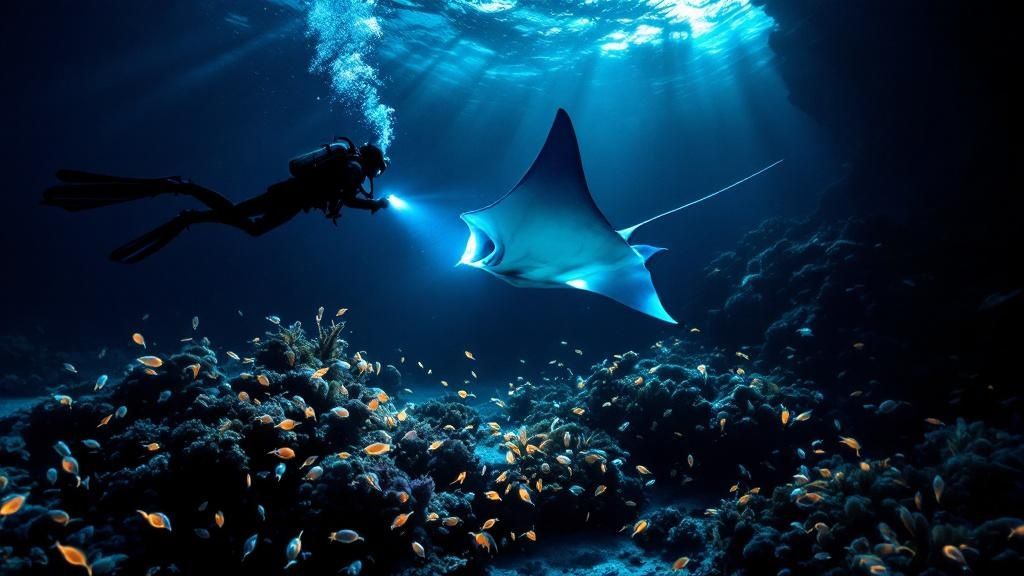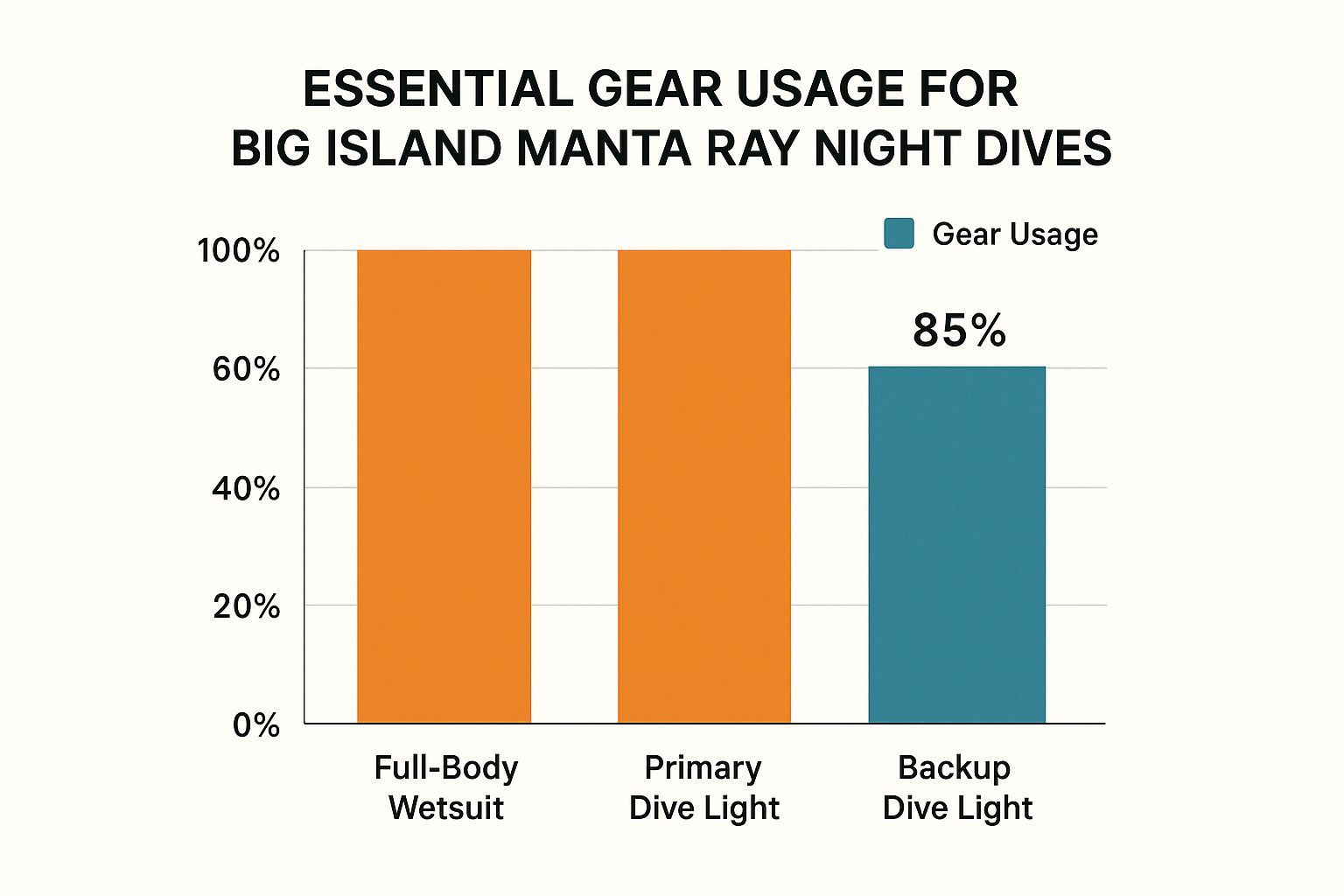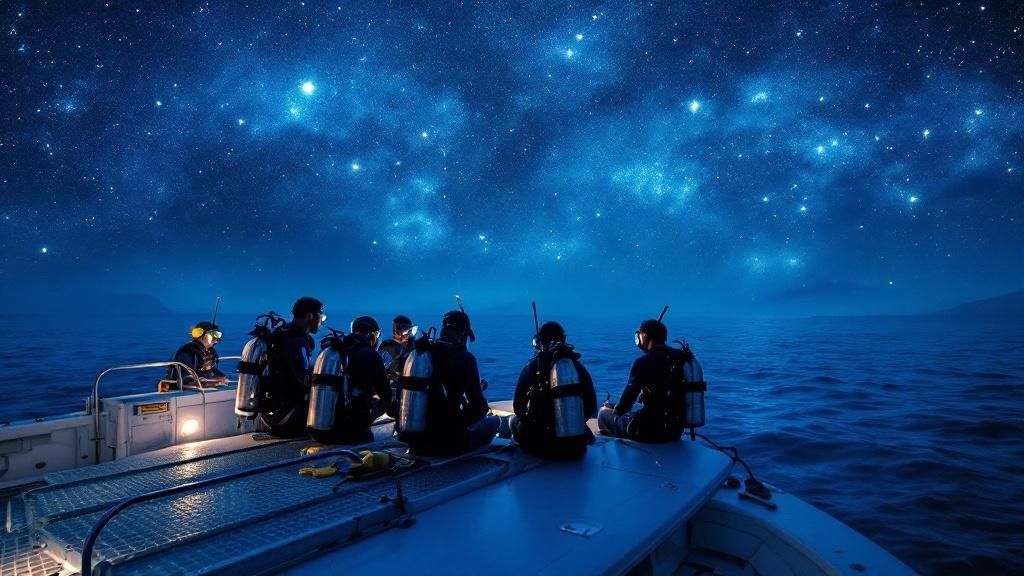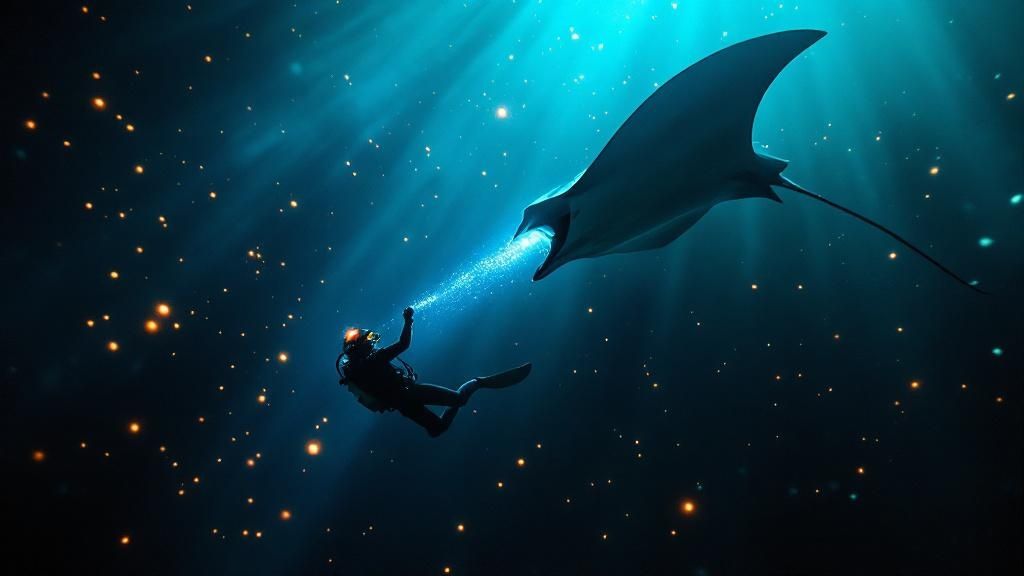Why This Underwater Experience Changes Everything
Imagine yourself floating in the dark, quiet Pacific, gently swayed by the ocean's rhythm. Then, a huge, graceful shadow emerges from the depths. A manta ray, with a wingspan that can reach 12 feet, glides through the illuminated water, its white underside glowing in the beams of your dive light. This isn't just a dive; it's a powerful encounter with a smart, majestic creature, one that will stay with you long after you resurface. This is the magic of a Big Island manta ray night dive.
Many divers find the experience almost spiritual. These gentle giants, despite their impressive size, move with an incredible grace, almost ethereal, as they dance through the water. They often seem curious about the divers, circling close in fluid, hypnotic movements. It's like watching a ballet performed by nature, just inches away. It's no wonder divers come out of the water feeling changed. This isn't passive observation; it's sharing a moment, a silent conversation of mutual curiosity and respect.
This amazing interaction is all thanks to the unique way manta rays eat. They're filter feeders, dining on microscopic plankton. The lights used on these dives attract the plankton, creating an all-you-can-eat buffet for the rays. Think of it like a porch light attracting moths – only much bigger and more captivating. Drawn by the bright plankton, the manta rays perform acrobatic barrel rolls and graceful loops, their huge mouths open as they filter their meal from the water.
The Big Island of Hawaii, specifically the Kona Coast, is famous for successful manta ray night dives. Divers and snorkelers usually have an 85% to 90% chance of seeing these magnificent creatures during their nightly feeding sessions. Want the latest sighting info? Check out this helpful resource: Find up-to-date manta ray sighting reports here.
You don't have to be a certified diver to experience this. Snorkelers can also witness this underwater spectacle, floating on the surface as the mantas perform their graceful ballet below. Whether you dive or snorkel, the Big Island manta ray night dive is more than just seeing wildlife. It's a journey into a world of wonder, a reminder of the deep beauty and mystery hidden beneath the ocean's surface. Learn more about the Kona Honu Divers manta ray night dive experience.
The Underwater Light Show That Creates Magic
Imagine a lavish buffet, not on land, but spread out in the dark depths of the ocean. Instead of gourmet dishes, the menu features billions of microscopic plankton, all drawn in by the irresistible glow of underwater lights. This, my friend, is the secret behind the mesmerizing manta ray night dive off Hawaiʻi’s Big Island. These gentle giants, with wingspans reaching 12 feet or more, aren't just passing by; they're responding to a fascinating chain reaction triggered by the lights.
It's not magic, but pure biology. Tiny zooplankton, the foundation of the ocean's food web, are naturally attracted to light sources – a behavior known as positive phototaxis. Think of moths drawn to a porch light. These plankton, usually scattered throughout the water, become concentrated around the light, creating a dense, irresistible feast for the manta rays. The lights aren't just for us to see; they’re the key ingredient in this manta ray smorgasbord.

The Manta Ray Ballet
The manta ray's signature "barrel roll" feeding technique, often mistaken for playful acrobatics, is a highly efficient way to filter these tiny organisms. As they execute these graceful spirals, the rays use their cephalic fins – those horn-like projections on their heads – to funnel the plankton-rich water directly into their mouths. This creates a swirling vortex, further concentrating the plankton and allowing the manta rays to maximize their intake with minimal effort. For a glimpse of this unforgettable experience, check out Manta Ray Night Snorkel in Hawaii: An Unforgettable Experience.
The Volcanic Advantage
The Big Island's volcanic origins play a critical role in this unique ecosystem. Volcanic activity releases nutrients into the surrounding ocean, fueling massive plankton blooms. These nutrient-rich waters create ideal conditions for abundant plankton growth, ensuring a constant food source for manta rays and other filter feeders. Between 2009 and 2014, underwater videographers meticulously documented manta ray sightings along the Kona Coast, gathering data on their movements and health. This research provides invaluable insights into the manta ray population and its relationship with the local environment. Discover more insights here. This delicate interplay of light, plankton, and volcanic activity makes the Big Island a truly special and reliable place to witness these magnificent creatures year after year. To dive deeper into the manta ray night dive experience with Kona Honu Divers, click here.
Where Giants Gather: Decoding The Best Dive Sites
Not all Big Island manta ray night dive sites are the same. Knowing the subtle differences between them can greatly enhance your diving experience. While Garden Eel Cove (also known as Manta Heaven) is the most famous, other spots along the Kona Coast offer unique perks. Understanding these nuances helps you pick the perfect dive for you and appreciate the diverse underwater world.
Garden Eel Cove's reputation comes from its reliably high manta ray sightings. Its relatively shallow, sandy bottom, combined with the sheltered nature of the cove, creates a perfect environment for plankton to accumulate under the dive lights. This predictable feast attracts manta rays in large numbers, sometimes even reaching double digits on a single dive. This makes it the "gold standard" for manta ray night dives on the Big Island.
But other sites, like Keahole Point, offer their own kind of magic. A bit deeper than Garden Eel Cove, Keahole Point boasts diverse coral formations and stronger currents. These conditions can attract a wider variety of marine life, adding another dimension to your dive. Plus, if conditions at Garden Eel Cove aren't ideal, Keahole Point can sometimes offer better visibility and calmer waters.
To help you visualize the gear commonly used on these dives, take a look at the infographic below:

The infographic shows that while a full-body wetsuit (100%) and primary dive light (100%) are used by everyone, backup dive lights are carried by 85% of divers. This emphasizes the importance of being prepared and having backup equipment for safety during night dives.
To give you a clearer picture of the dive site options, let's compare them side-by-side:
To help you choose the right dive site for your experience level and interests, here's a comparison table:
Big Island Manta Ray Dive Sites Comparison: This table compares the main manta ray dive sites, including their depth, difficulty level, typical visibility, and unique features.
| Dive Site | Depth Range | Difficulty Level | Average Visibility | Unique Features |
|---|---|---|---|---|
| Garden Eel Cove (Manta Heaven) | 30-40ft | Beginner | 40-60ft | Shallow, sandy bottom, high manta ray concentration |
| Keahole Point | 40-50ft | Intermediate | 50-70ft | Diverse coral formations, stronger currents, potential for diverse marine life |
| Other Kona Coast Sites | Varies | Varies | Varies | May offer unique topography and marine life encounters |
As you can see, each site has its own unique characteristics. Garden Eel Cove is ideal for beginners due to its shallow depth and calm conditions, while Keahole Point offers a more challenging dive for experienced divers. Other sites along the Kona Coast can offer unique underwater landscapes and marine life depending on the specific location.
Choosing a dive operator familiar with these sites is essential. Experienced guides understand how factors like surge, visibility, and water temperature affect each location. They know when to adjust dive plans for the best manta ray encounters, making sure you have a fantastic experience. For a curated list of recommended manta ray night dive tours, check out this helpful resource: Top 5 Manta Ray Night Dive Tours. By understanding the subtle differences between dive sites, you’ll be better prepared to choose the operator and location that perfectly aligns with your expectations, leading to an unforgettable experience with these gentle giants.
Timing Your Perfect Underwater Encounter

The Big Island welcomes manta ray enthusiasts year-round. Like choosing the perfect seat for a concert, you can see the show anytime, but certain times provide an even more captivating experience. Manta ray night dives here aren't restricted by seasons. Dive sites like Garden Eel Cove and the area near Keahole Point offer relatively shallow dives, typically between 30 to 40 feet deep. Discover more insights. But understanding the interplay of the lunar cycle, ocean conditions, and even boat traffic can significantly enhance your dive.
For example, the moon phase plays a key role in plankton activity. A new moon, with its minimal light, makes the dive lights the main attraction for plankton, creating a focused feeding frenzy for the manta rays and often resulting in closer encounters.
On the other hand, a full moon can disperse the plankton, leading to more scattered manta ray activity. Think of it like a buffet – a concentrated food source draws a crowd, while a spread-out buffet leads to smaller groups scattered around. You might be interested in: What is Manta Ray Night Dive?
Decoding Ocean Conditions
Ocean conditions also contribute to the experience. While calm seas may seem ideal, slightly choppy water can sometimes stir up nutrient-rich colder water from the depths, creating a plankton feast and attracting more manta rays. It's like shaking up a snow globe – a little disturbance can create a flurry of activity.
Wind also affects visibility. The typically clear waters of the Kona Coast can become cloudy after heavy rains. Yet, paradoxically, some "bad weather" days bring the clearest visibility as the wind pushes sediment away, much like sweeping dust off a table.
Considering Other Factors
Boat traffic is another factor. Too many boats can disrupt the manta rays' feeding patterns, while a quieter night might offer a more personal experience. Imagine trying to enjoy a meal with a lot of commotion around you – a peaceful setting is always more enjoyable.
While seasonal changes don't limit manta ray sightings, they do influence other marine life you might encounter. You might spot a curious moray eel or a school of colorful reef fish also attracted to the lights, adding another layer of wonder to your dive.
Considering these seemingly small details can truly elevate your Big Island manta ray night dive. Talking to your dive operator, like Kona Honu Divers, about these specifics can offer valuable insights into the current conditions and help you choose the perfect time for your unforgettable underwater adventure.
Mastering Night Diving With The Right Gear

A Big Island manta ray night dive is a truly special experience, but it calls for more than your average scuba kit. It’s about maximizing your enjoyment and staying safe in a darker, more demanding environment. Think of it like the difference between a night hike and a sunny stroll in the park—proper preparation is key. With the right equipment, these graceful giants will transform from shadowy figures into vibrantly illuminated wonders.
The Importance of Light
Your primary dive light is absolutely essential. It acts like an underwater buffet table, attracting the plankton that the manta rays feed on. But not all dive lights are equal. A wide-beam light is much better for manta dives than a narrow spotlight. Think of it like casting a wide net – a broader beam illuminates a larger area, drawing in more plankton and giving you a wider view of the manta rays’ elegant movements. A bright, dependable light is also a must-have for both attracting the mantas and maintaining visibility in the dark. Curious to know more about this amazing experience? Check out Why should you go on a manta ray dive in Kona?
Backup is Key
Just like a spare tire in your car, a backup dive light is non-negotiable. Imagine your primary light failing mid-dive—a backup ensures you’re not plunged into total darkness. It gives you the ability to safely navigate back to the boat and signal for help if needed. This backup should be small but powerful enough to get you out of a tricky situation.
Buoyancy and Safety
Good buoyancy control is even more critical at night. You’ll want to avoid stirring up the sandy bottom or accidentally bumping into coral. This can disrupt the manta rays' feeding and harm the delicate reef. It’s like walking carefully in a darkened room—gentle, controlled movements prevent unwanted disturbances. Specialized night diving techniques, like using your dive light to anticipate your fin kicks, can help you maintain perfect buoyancy and avoid contact with the environment.
Thermal Protection
Even though Hawaiian waters are generally warm, extended periods in the water at night can cause heat loss. A full-body wetsuit provides essential thermal protection, keeping you comfortable throughout your dive. This lets you focus on the amazing manta rays without being distracted by the cold. It's not just about comfort, it's a safety measure that helps prevent hypothermia.
Before we dive deeper (pun intended!), let's review the key equipment you'll need for a successful and safe manta ray night dive. The following table provides a comprehensive checklist.
Manta Ray Night Dive Equipment Checklist
Complete equipment checklist with essential, recommended, and optional gear for manta ray night diving
| Equipment Category | Essential Items | Recommended Additions | Photography Gear |
|---|---|---|---|
| Lights | Primary dive light (wide beam), Backup dive light | Dive light canister light | Underwater housing, Strobe, Wide-angle lens |
| Safety | Dive computer, Surface marker buoy (SMB), Whistle | Dive alert, Compass | Spare batteries, Memory cards |
| Exposure Protection | Full-body wetsuit | Hood, Gloves, Boots | – |
| Other | Fins, Mask, Snorkel, BCD, Regulator | Reef safe sunscreen | – |
This checklist helps ensure you have everything necessary for a comfortable and memorable experience, from the essentials like your dive computer and wetsuit to specialized photography equipment. Remember, proper preparation is crucial for any dive, especially a night dive.
By paying attention to these equipment considerations, you’ll be well-prepared to experience the magic of a Big Island manta ray night dive. You’ll be safe and ready for a genuinely unforgettable encounter with these gentle giants.
Your Complete Underwater Adventure Journey
Every manta ray night dive off the Big Island is a unique experience, but knowing the general flow helps you appreciate every moment. From the initial boat departure to the post-dive buzz, we'll walk you through the entire journey, including those important pre-dive briefings where you'll learn about manta ray behavior and how to interact respectfully.
The Descent into Darkness
Picture this: you slip beneath the waves, the world above transforming into a muted glow as you descend into the inky black. Your dive light cuts through the darkness, attracting tiny organisms that shimmer and swirl like living glitter. This is where the magic begins. These tiny creatures, drawn to the light like moths to a flame, are the very reason the manta rays will soon grace us with their presence. This initial descent sets the stage for the incredible show that's about to begin.
The Supporting Cast
As you wait, you’ll notice other marine life attracted by the light. A curious moray eel might peek out from its rocky hideaway, or schools of vibrant reef fish will dart in and out of your light beams, performing an ethereal underwater ballet. This supporting cast adds another layer of wonder to the experience, showcasing the rich biodiversity of the area. It's a beautiful reminder that you're a guest in a larger ecosystem, sharing this special moment with the other inhabitants of the deep.
The Manta Ray Arrival
Then, the moment you've been waiting for: a shadow materializes from the darkness, growing larger and larger as it approaches. Your first manta ray appears, gliding effortlessly through the water as if defying gravity. It’s a truly breathtaking moment, often described as both humbling and exhilarating. The sheer size and grace of these magnificent creatures is simply awe-inspiring.
Multiple Manta Rays and Positioning
Sometimes, multiple manta rays arrive at once, creating a mesmerizing ballet of swirling giants. It’s crucial to remain calm and follow the guidance of your dive instructors. They’ll show you how to position yourself for the best possible view without disrupting the manta rays’ feeding patterns. Imagine being surrounded by these gentle giants, their movements synchronized and elegant. It’s an experience that will stay etched in your memory long after you return to the surface.
Making Memories That Last
The emotional impact of these encounters is often powerful. It's a blend of awe, wonder, and a profound connection with the natural world. Prepare to be moved by the sheer beauty and grace of these creatures. We'll also share tips on how to capture these memories, from underwater photography advice to journaling prompts that help you process the experience. This will allow you to relive the magic of your Big Island manta ray night dive for years to come.
Choosing Your Dive Operator Like a Pro
Picking the right dive operator can make or break your Big Island manta ray night dive experience. It's the difference between a decent dive and one you'll remember forever. With so many choices, it's easy to get overwhelmed. But don't just go for the cheapest option – a truly memorable experience requires a little more thought.
Key Factors to Consider
Choosing a dive operator is a bit like choosing a restaurant. Price is a factor, sure, but you'd also consider the menu, the atmosphere, and what other diners have to say. The same goes for dive operators.
-
Group Size: Smaller groups often mean a more personalized experience. Imagine trying to share a magical moment with a manta ray while surrounded by a crowd. A smaller, more intimate setting allows for a more focused, less cluttered encounter.
-
Guide Experience: A knowledgeable guide is like having a local expert by your side. They understand the nuances of the local waters, the manta rays' behavior, and the best viewing spots. This expertise can significantly enhance your dive.
-
Boat Comfort and Features: Don’t forget about the boat itself! Is it comfortable and spacious? Does it offer amenities like hot showers and post-dive snacks? These small comforts can make a big difference in your overall enjoyment.
Safety First
Safety should always be your top concern. Look into the operator’s safety record and ask about their emergency procedures. Find out how experienced their crew is. A responsible operator puts safety first, above all else.
Tour Formats and Trade-offs
Different tour formats cater to different needs and budgets. A small, six-person tour offers a more personalized experience, while a larger boat operation might be more budget-friendly. It's a trade-off, like choosing between a boutique hotel and a large resort – both have their advantages.
Booking Strategies and Red Flags
Booking in advance, especially during peak season, is essential to secure your spot on the best tours. Don’t hesitate to ask specific questions about maximum group sizes, guide-to-diver ratios, and cancellation policies. Vague or hesitant answers should be seen as a red flag.
Considerations for Different Experience Levels
If you're new to night diving, choose an operator specializing in beginner-friendly experiences, with patient guides and smaller groups. Underwater photographers should seek out operators who know the prime spots for capturing incredible images.
Add-on Services: Value vs. Fluff
Some add-ons, like underwater photography packages or specialized equipment rentals, can truly enhance your dive. Others might be unnecessary upsells. Be sure to distinguish between genuine value and added fluff.
Choosing the right dive operator is key to an unforgettable Big Island manta ray night dive. Kona Honu Divers offers a range of tours for all experience levels, with a focus on safety and personalized service. Explore our offerings and book your adventure today!
